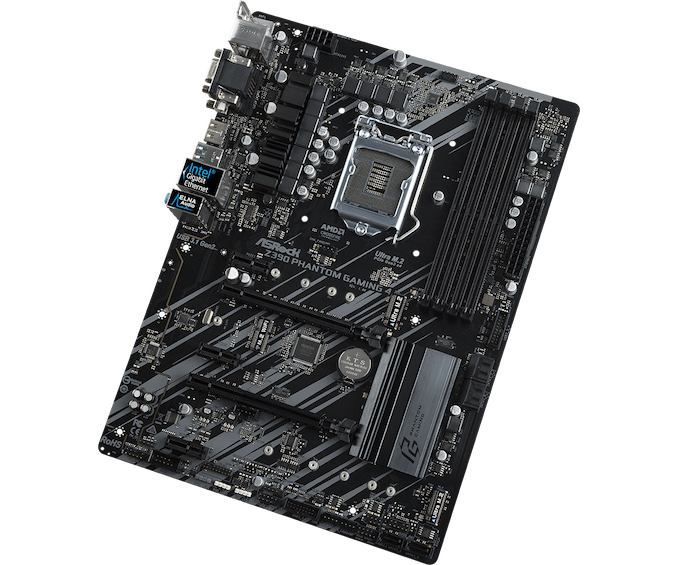Intel Z390 Motherboard Overview: 50+ Motherboards Analyzed
by Ian Cutress & Gavin Bonshor on October 8, 2018 10:53 AM EST- Posted in
- Motherboards
- Intel
- MSI
- Gigabyte
- ASRock
- EVGA
- Asus
- NZXT
- Supermicro
- Z390
ASRock Z390 Phantom Gaming 4
With the Z390 Phantom Gaming 4, ASRock has dropped the flashy LED lighting integrated into the heatsinks and offers users a further cut-down version at an entry-level price point ($140). The Z390 Phantom Gaming 4 keeps the same black and grey PCB theme, it removes the rear panel cover from the other Phantom Gaming boards outlined above and removes one of the power delivery heatsinks; this model is advertised as having a lower spec 10-phase power delivery. Also omitted from the Z390 Phantom Gaming 4 is Steel Slot protection. The board has two full-length PCIe 3.0 slots which run at x16 and x4 respectively, along with a total of three PCIe 3.0 x1 slots. Users looking to run SLI on a budget will need to look at ASRock's Z390 Phantom Gaming SLI board which is similar but costs $20 more.
The memory capability of the Z390 Phantom Gaming 4 consists of support for up to 64 GB of DDR4 memory and up to DDR4-4300. The board offers six SATA ports with support for RAID 0, 1, 5 and 10 arrays. Included are two PCIe 3.0 x and SATA compatible M.2 slots and on the cooling front, the Z390 Phantom Gaming 4 offers a total of four 4-pin fan headers.
On the rear panel, the Z390 Phantom Gaming 4 has two USB 3.1 Gen2 consisting of a single Type-A and Type-C port with two USB 3.0 Type-A and USB 2.0 ports. A single LAN port powered by an Intel I219V Gigabit networking controller and the three 3.5 mm audio controlled by a Realtek ALC892 HD codec are also featured. Just like the Z390 Phantom Gaming 6, the Z390 Phantom Gaming 4 has a trifecta of video outputs which are comprised of a D-sub, a DisplayPort and a single HDMI output.
With a much lower entry point into the market than the bigger Phantom Gaming 6 and 9 motherboards, the ASRock Z390 Phantom Gaming 4 has a price of $140 which makes it the third cheapest Z390 board in ASRock's current SKU list and with Intel Gigabit LAN and a mid-ranged Realtek ALC892 codec, the Gaming 4 is seemingly targeted at gamers not looking to spend allocated budget on flashy aspects such as RGB and SLI support, but instead sticks to the important core componentry with minimal fuss.












79 Comments
View All Comments
Smell This - Tuesday, October 9, 2018 - link
Much.Of.
The.
Same.
2 HSIO lanes per Gen 2 port and WiFi. Wow (rolling I-eyeballs) ...
MadAd - Tuesday, October 9, 2018 - link
58 motherboards, only 13 of which are smaller than ATX. When on earth are we going to move off this outdated oversized format? Its just more of the same every time, so depressing.gavbon - Wednesday, October 10, 2018 - link
13 is better than 0, or 12 :DMadAd - Wednesday, October 10, 2018 - link
Considering very small form formats (ITX) are harder to build for and only 7 are uATX, a size which is the most useful to transition away from ATX then no, it feels like an afterthought from a lazy industry. I mean who uses more than 1 main video card and 2-4 sticks of ram in a gaming PC these days? Even water builds into uATX isnt that hard to accomplish.After literally decades ATX should be a choice for edge cases not a mainstream build.
shaolin95 - Monday, October 22, 2018 - link
who cares about midge boards!Edkiefer - Wednesday, October 10, 2018 - link
All these MB with 2x 8 pin power inputs, is both mandatory and if so I guess new PSU will need 2x 8pin now.entity279 - Wednesday, October 10, 2018 - link
so it's ok to just buy SM motherboards now with them being involved in a security scandal?gavbon - Thursday, October 11, 2018 - link
I currently have the Supermicro C9Z390-PGW awaiting to go on the test bench next week, so from a consumers standpoint, I could potentially shed light on that board. As far as the Chinese/Supermicro/Spy scandal goes, I don't want to speculate without the finer details.eastcoast_pete - Wednesday, October 10, 2018 - link
Ian & Gavin, thanks for the overview.@ both - Question: I've read that Intel, to deal with its bad planning/capacity problems on 14 nm, has contracted the fabbing of some of its chipsets out to TSMC, specifically in TSMC's 22 nm tech. Is that correct, and did you have a chance to confirm that the new 390s used by these boards are indeed made by Intel on their 14 nm FinFET tech, or are they made by a contractor (TSMC)?
DanNeely - Wednesday, October 10, 2018 - link
AFAIK the chipsets being reverted to 22nm are using Intel's 22nm process in old unupgraded fabs. Doing so would be far less work than porting to a process from a different company; the latter would require massive rework to follow a completely different set of design rules.